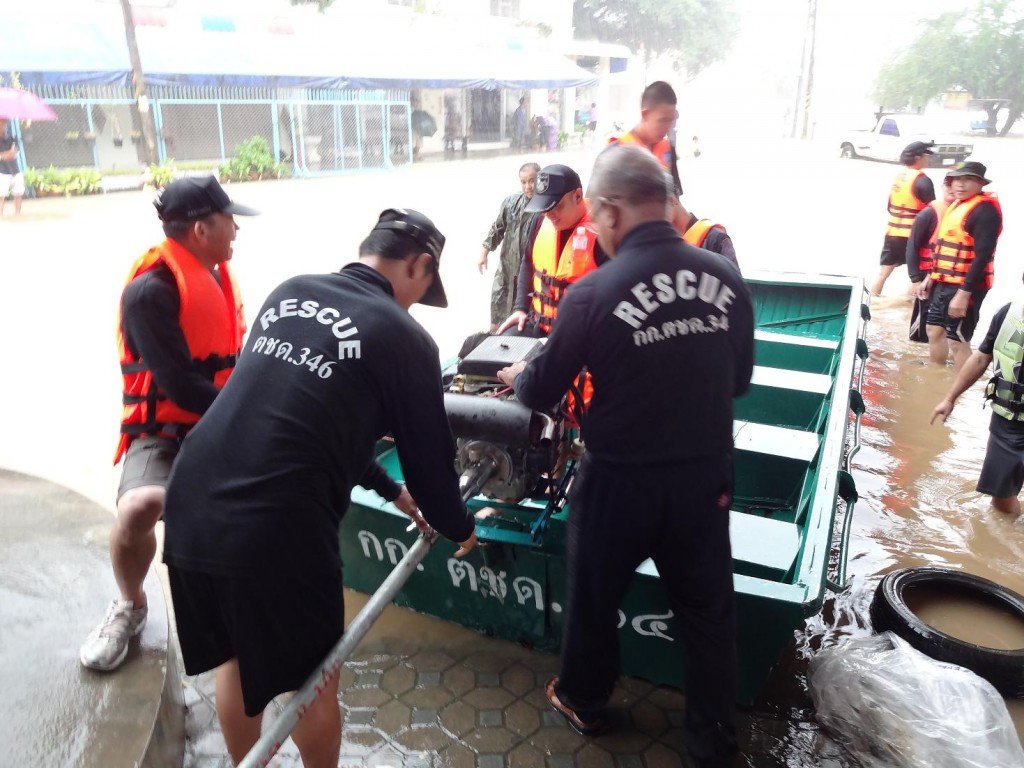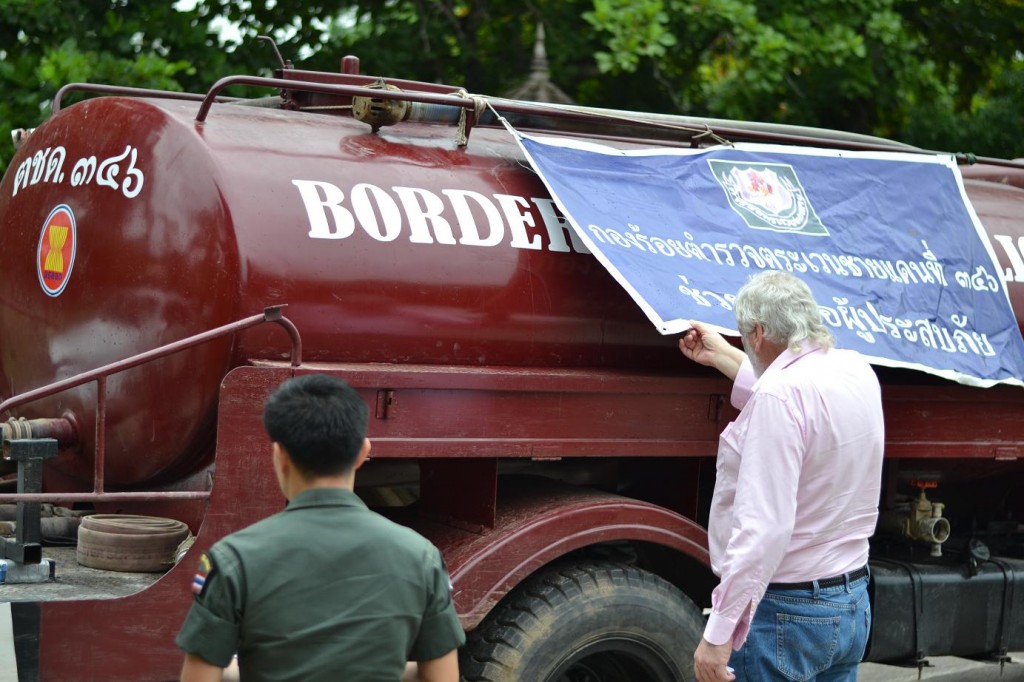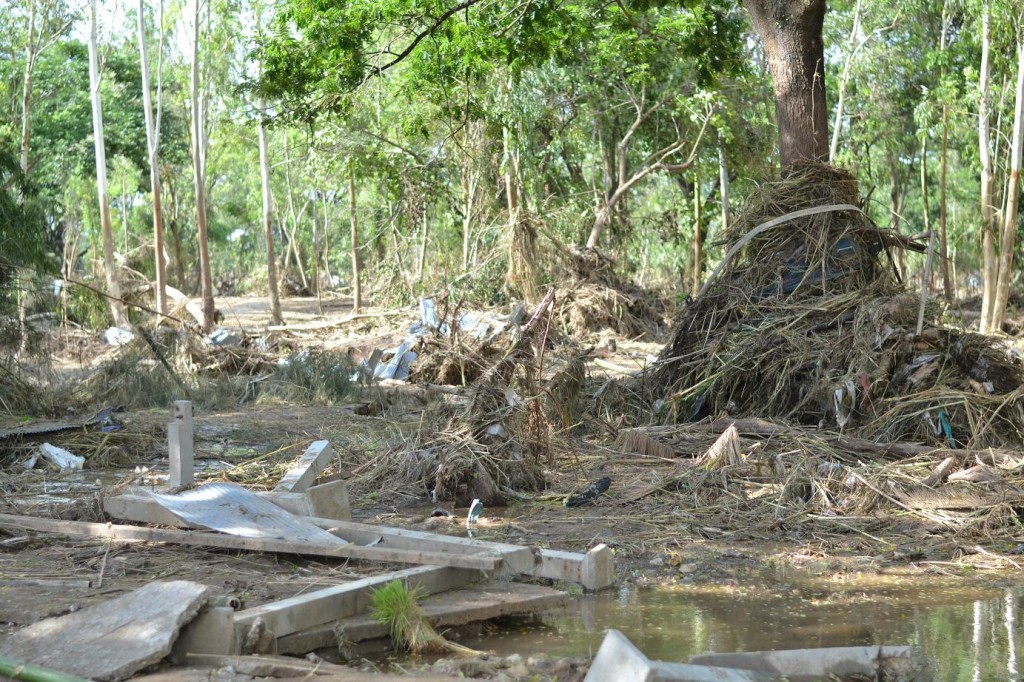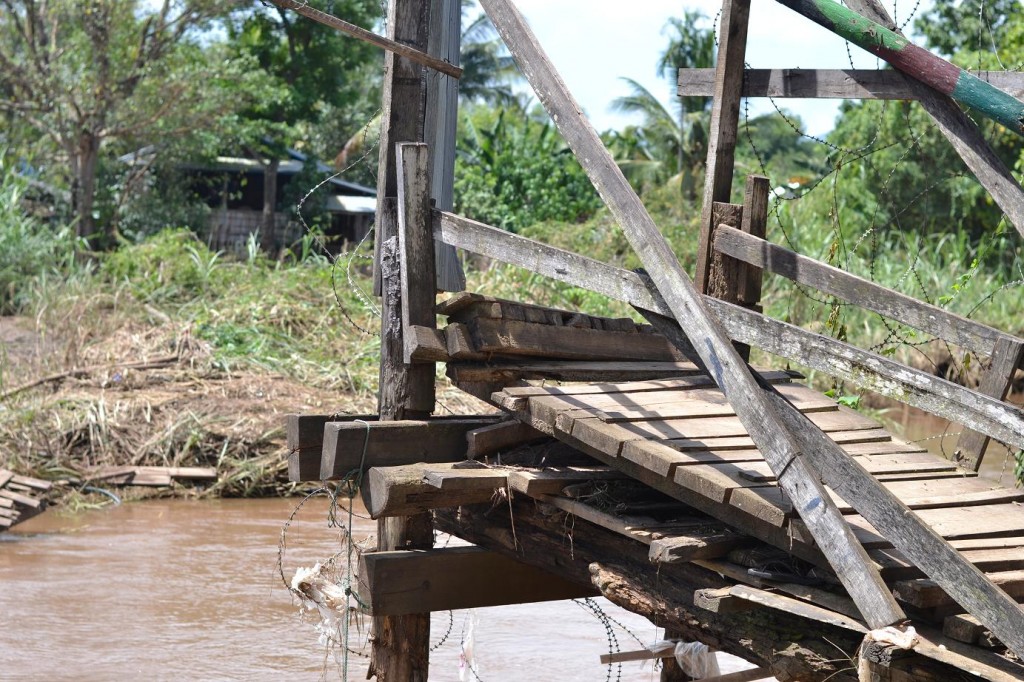The Thai Border Patrol Police (BPP) and the Floods in Mae Sot, 29 July – 2 August 2013
From 29 July through 2 August 2013, the Mae Sot area, in Tak Province was afflicted with severe floods, reckoned to be the worst in more than twenty years. On the afternoon of 29 July, after a week of heavy rain, flood-waters suddenly rose, in the space of less than an hour, to more than a metre high in the central part of the town itself. The Moei River burst its banks, and water rose by 4-5 metres along some of its edges, including at the Rim Moei markets next to the Friendship Bridge across the river between Rim Moei and Myawaddy in Burma. The famous Mae Tao Clinic (Dr Cynthia’s), just west of the town, on the road to Rim Moei, was closed, as water reached 1.5 metres, flooding the reproductive health, child health, and surgical areas as well as staff accommodation.
Flash floods of these dimensions have become an almost annual event in Mae Sot/Rim Moei; this was more damaging than previous ones because, at least along the river-sides, it lasted four days, whereas the previous ones typically lasted no more than two days, such as those in July-August 2011 and in August 2012. Cross-border trade was suspended for these four days, causing business losses amounting to an estimated 1.2 billion baht. Many houses and shops in the town were seriously damaged. Along the river-sides, many were completely destroyed.
The BPP’s 346th Company, based in Tambon Tha Sai Luat, opposite the Mae Sot airport, about four kilometres west of the centre of Mae Sot or about half-way between Mae Sot and Rim Moei, quickly took responsibility for rescue, relief and, by 3 August, clean-up operations. These were personally directed by Lieutenant Colonel Chaiwarut Promyard, the energetic company commander who exercised hands-on command.
On 29 July, as the heavy rain continued, the Moei broke its banks and the flood-waters began rising rapidly, Chaiwarut supervised the rescue operations from a relatively dry spot under the Friendship Bridge. His first task was to a get a BPP boat into the water, with a crew trained in rescue techniques. Many people were saved from life-threatening situations on both sides of the swollen river.
On 30 July, and over the next several days, the company concentrated on emergency relief operations. Drinking water and packages of rice and dried food were distributed to hundreds of people affected by the floods. In addition to bottled water, a tanker truck was used to disburse larger quantities of clean water for washing and assuring personal hygiene.
The worst affected area was about two km south of the Friendship Bridge, an area with lower banks and widely used by local traders for cross-river shipments. The flood-waters here rose higher than five metres, damaging or destroying numerous houses and warehouses, and depositing considerable amounts of debris. An office building used by the 346th Company for monitoring cross-river movements was among the wreckage. Lieutenant Colonel Chaiwarut spent almost all of the Saturday, 3 August, organising relief and clean-up operations in this area.
Further southwards along the Moei, severe damage was wreaked in the areas around Ban Waley, in Tak’s Phop Phra Distict, about 40 km south of Mae Sot, near the beginning of the Moei River, and at Ban Mae Khon Kaen, in Tambon Mahawan, about 16 km south of Mae Sot township, opposite Phalu. At Ban Waley, the wooden foot-bridge used by local villagers to cross between the Thai and Burmese sides was washed away. On the Burmese side, only the portal with the DKBA flag and a photo of U Thuzana, the spiritual leader of the DKBA, was left standing. A temporary walk-way was emplaced by 5 August.
At Ban Mae Khon Kaen, where the water rose by more than 5 metres, the alignment of the river and hence the border-line itself was substantially changed. A new island was formed, and the bank on the Burmese side was moved back by about 20 metres. For around two decades, such changes have occasioned conflict between Burmese and Thai authorities.
For example, a conflict broke out over a new island in the river in September 1994. Heavy rain in July 1993 caused the river to overflow and change its course, leaving 1,100 rai of former Thai land, of which 340 rai of good agricultural land had been used by Thai farmers, in the middle of the river. The 34th Task Force commander ordered that Thai national flags be planted on the island, called Koh Manao (Manao Islet), and that a BPP unit (consisting of personnel from the 346th Company) be stationed at Ban Mae Khon Kaen to ensure safety for Thai farmers.
The BPP unit at Ban Mae Khon Kaen was put on alert in July 1997 when local villagers reported sighting Burmese soldiers gathering near the islet. Members of the 346th Company were again sent to secure the area in February 2001 when a Thai villager was shot and seriously wounded by Burmese soldiers while fishing near the islet. A platoon from the 346th Company has since been based on a hill about 100 metres from the river. In July-August 2013, this was the 3464th Platoon, personnel from which have been watching anxiously for the response of the Burmese authorities, and of local farmers, to the loss of their land.
Lieutenant Colonel Chaiwarut Promyard, commander of the 346th Company, Rim Moei, 29 July 2013
Members of the 346th Company, Rim Moei, 29 July 2013
Members of the 346th Company, Rim Moei, 29 July 2013
Preparing for relief operations, 346th Company’s HQ, 3 August 2013
Preparing for relief operations, 346th Company’s HQ, 3 August 2013
Preparing for relief operations, 346th Company’s HQ, 3 August 2013
Preparing for relief operations, 346th Company’s HQ, 3 August 2013
Flood debris, Moei River, 3 August 2013
Flood debris, Moei River, 3 August 2013
Flood debris, Moei River, 3 August 2013
346th Company’s office, Moei River, 3 August 2013
346th Company’s office, Moei River, 3 August 2013
Organising relief and clean-up operations, Moei River, 3 August 2013
Organising relief and clean-up operations, Moei River, 3 August 2013
Organising relief and clean-up operations, Moei River, 3 August 2013
Organising relief and clean-up operations, Moei River, 3 August 2013
Waley, Phop Phra District, 5 August 2013
Waley, Phop Phra District, 5 August 2013
Moei River, Ban Mae Khon Kaen, 5 August 2013
Des Ball is a Special Professor in the Australian National University’s College of Asia and the Pacific. Olivia Cable is a graduate student at the same institution. In late 2013 Ball’s two-volume study of Thailand’s Border Patrol Police will be published by White Lotus.
 Facebook
Facebook  Twitter
Twitter  Soundcloud
Soundcloud  Youtube
Youtube  Rss
Rss 


















